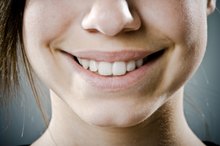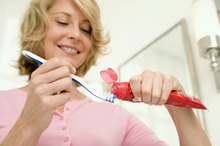Baking Soda & Peroxide for a Teeth Whitener
Many people struggle with the color of their teeth. Drinking tea, coffee and cola, smoking and even some of the foods you eat contribute to the discoloration of your teeth. A trip down the toothpaste aisle will present you with a variety of products that claim to whiten teeth. While many of these products proclaim peroxide or baking soda can give you a whiter smile, you can’t just mix up a paste at home. These products contain various amounts of whitening agents, and the ingredients each work in their own way.
Types
At-home tooth whitening strips contain a thin film of carbamide peroxide or hydrogen peroxide on top of a thin layer of plastic. You wrap the plastic around your front teeth and allow the hydrogen peroxide to bleach the surface of your teeth for about 30 minutes twice a day. This bleaching process, repeated over time, can make your teeth appear whiter.
If you have a dentist whiten your teeth, he will use a higher concentration of hydrogen peroxide than you can find at your local pharmacy. This 15 to 35 percent concentration bleaching agent is often combined with the use of a light or laser to accelerate the whitening process.
Whitening toothpastes generally contain chemical or polishing agents, such as baking soda, instead of bleaching agents. However, some over-the-counter brands do contain hydrogen peroxide as well. Look for whitening toothpastes that carry the American Dental Association, or ADA, seal of approval 1.
- At-home tooth whitening strips contain a thin film of carbamide peroxide or hydrogen peroxide on top of a thin layer of plastic.
- This 15 to 35 percent concentration bleaching agent is often combined with the use of a light or laser to accelerate the whitening process.
Function
Can You Whiten Teeth With Orange Peels?
Learn More
The ADA defines “whitening” as “any process that will make teeth appear whiter.” Professionally applied and over-the-counter products containing peroxide bleach your teeth and physically change their color. Baking soda and other similar micro-abrasive agents polish away surface stains but do little to remove deep stains.
Time Frame
In a 2006 review by the Cochrane Collaboration, researchers from the University of Michigan measured the effectiveness of several over-the-counter and dentist-dispensed tooth whiteners containing peroxide. They found that the use of tray-applied gels, paint-on films or whitening strips for two or more weeks whitened teeth more than not using any whitening treatment.
Considerations
Side Effects of Whitening With Carbamide Peroxide
Learn More
The New Jersey Dental School recommends talking to your dentist prior to starting any at-home whitening treatment. Teeth whitening products that contain bleaching agents, such as hydrogen peroxide, should generally be used for a two- to four-week period. Using it longer than this could cause damage to your teeth or gums. The use of at-home bleaching products often causes tooth sensitivity and gum irritation. However, the Cochrane reviewers note that these side effects generally stop after treatment. The safest and most effective option for tooth whitening is to have it done professionally in a dentist’s office 1. A rubber dam or gel protects your gums during the procedure, and it generally takes about an hour to complete the process.
- The New Jersey Dental School recommends talking to your dentist prior to starting any at-home whitening treatment.
- A rubber dam or gel protects your gums during the procedure, and it generally takes about an hour to complete the process.
Expert Insight
Whitening toothpastes that contain abrasives like baking soda actually do very little to change the color of your teeth, reports Dr. Martin Giniger of the New Jersey Dental School. Because they don’t contain the same bleaching agents found in dentist-prescribed whitening systems and they spend so little time in contact with your teeth, you will not see much change in your teeth. However, the baking soda or other abrasives contained in whitening tooth paste will remove some surface stains and give your teeth a shiny, polished appearance. The best use of whitening toothpaste is to maintain a bright, white smile after having your teeth professionally whitened, according to Dr. Giniger.
- Whitening toothpastes that contain abrasives like baking soda actually do very little to change the color of your teeth, reports Dr. Martin Giniger of the New Jersey Dental School.
Related Articles
References
- American Dental Association: Statement on the Safety and Effectiveness of Tooth Whitening Products
- Carey CM. Tooth whitening: what we now know. J Evid Based Dent Pract. 2014;14 Suppl:70–76. doi:10.1016/j.jebdp.2014.02.006
- Bersezio C, Martín J, Angel P, et al. Teeth whitening with 6% hydrogen peroxide and its impact on quality of life: 2 years of follow-up. Odontology. 2019;107(1):118–125. doi:10.1007/s10266-018-0372-3
- Matis BA, Matis JI, Wang Y, Monteiro S, Al-Qunaian TA, Millard R. Labeled vs actual concentration of bleaching agents. Oper Dent. 2013;38(3):334–343. doi:10.2341/11-367-L
- Féliz-Matos L, Hernández LM, Abreu N. Dental Bleaching Techniques; Hydrogen-carbamide Peroxides and Light Sources for Activation, an Update. Mini Review Article. Open Dent J. 2015;8:264–268. Published 2015 Jan 6. doi:10.2174/1874210601408010264
- Kugel G, Ferreira S. The art and science of tooth whitening. J Mass Dent Soc. 2005;53(4):34–37.
- Fiorillo L, Laino L, De Stefano R, et al. Dental Whitening Gels: Strengths and Weaknesses of an Increasingly Used Method. Gels. 2019;5(3):35. Published 2019 Jul 4. doi:10.3390/gels5030035
- Ghalili KM, Khawaled K, Rozen D, Afsahi V. Clinical study of the safety and effectiveness of a novel over-the-counter bleaching tray system. Clin Cosmet Investig Dent. 2014;6:15–19. Published 2014 Feb 21. doi:10.2147/CCIDE.S59292
- Sulieman M. An overview of bleaching techniques: 2. Night Guard Vital Bleaching and non-vital bleaching. Dent Update. 2005;32(1):39-40, 42-4, 46.
- Swift EJ Jr, Heymann HO, Wilder AD Jr, Barker ML, Gerlach RW. Effects of duration of whitening strip treatment on tooth color: a randomized, placebo-controlled clinical trial. J Dent. 2009;37 Suppl 1:e51–e56. doi:10.1016/j.jdent.2009.05.009
- Epple M, Meyer F, Enax J. A Critical Review of Modern Concepts for Teeth Whitening. Dent J (Basel). 2019;7(3):79. Published 2019 Aug 1. doi:10.3390/dj7030079
- Kalliath C, Mukunda A, Pynadath M, Venugopal V, Prethweeraj J. Comparison between the effect of commercially available chemical teeth whitening paste and teeth whitening paste containing ingredients of herbal origin on human enamel. Ayu. 2018;39(2):113–117. doi:10.4103/ayu.AYU_82_18
- "Tooth Whitening Treatments," American Dental Association. 18 September 2007.
Writer Bio
Educated at the Elkhart Area Career Center in Indiana, Amanda Tromley has worked as an illustrator and graphic designer for more than 10 years. Additionally, she writes and designs a blog that provides tips, tutorials, and tools for professional and amateur artists. Tromley began writing professionally in 2007 with articles on a variety of topics appearing in print newsletters and popular websites, including eHow.








